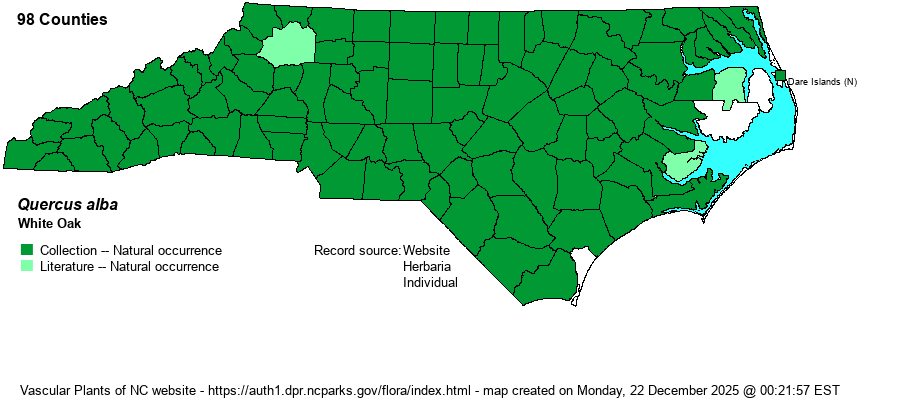| Author | L. | |
| Distribution | Occurs statewide, and is certainly present in all 100 counties, though of spotty occurrence in the far eastern counties.
The species is the most characteristic species of the Eastern oak-hickory forests in North America, ranging from southern Canada to northern FL, west to the eastern edge of the Great Plains.
| |
| Abundance | Common to abundant nearly everywhere in the state, except infrequent to fairly common in some areas close to the coast. On barrier islands restricted to northern Dare County. Ranges in the Mountains perhaps up to about 5000 feet. | |
| Habitat | This is often the dominant tree species in mesic forest conditions, on gentle slopes and drier flats. It is less numerous in dry sites, such as ridges and sandhills. It is the most common species of the Dry-Mesic Oak-Hickory Forest natural community. |
| Phenology | Flowers in spring, with acorns maturing in the same year, in fall (September-November). | |
| Identification | This is one of the more easily identified oak species, owing to the hand-like leaves, with usually 7-11 long but rounded lobes. It is a large and tall deciduous tree, often to 100 feet tall or more. Its bark is fairly distinctive, being pale to medium gray with somewhat loose ends to the narrow vertical plates, at least on larger trees. Over most of the state, it should not be confused with other oaks, but a few rare species such as Swamp White Oak (Q. bicolor), and especially Bluff Oak (Q. austrina), can grow with it in a few places. Check those species accounts for identification. | |
| Taxonomic Comments | None, though it may or can hybridize with a few other species.
| |
| Other Common Name(s) | None. However, it should be noted that “White Oak” is a nested name within a few other species, such as Swamp White Oak. Confusion is not likely, as White Oak has never had any other widely used common name. | |
| State Rank | S5 | |
| Global Rank | G5 | |
| State Status | | |
| US Status | | |
| USACE-agcp | FACU link |
| USACE-emp | FACU link |

